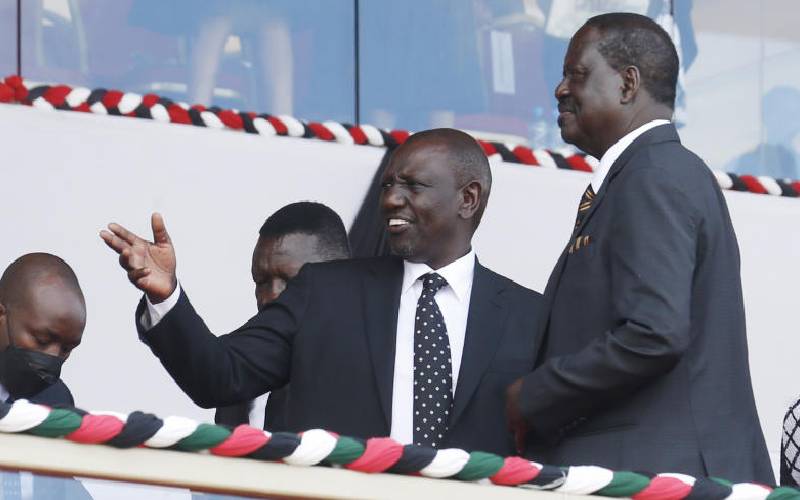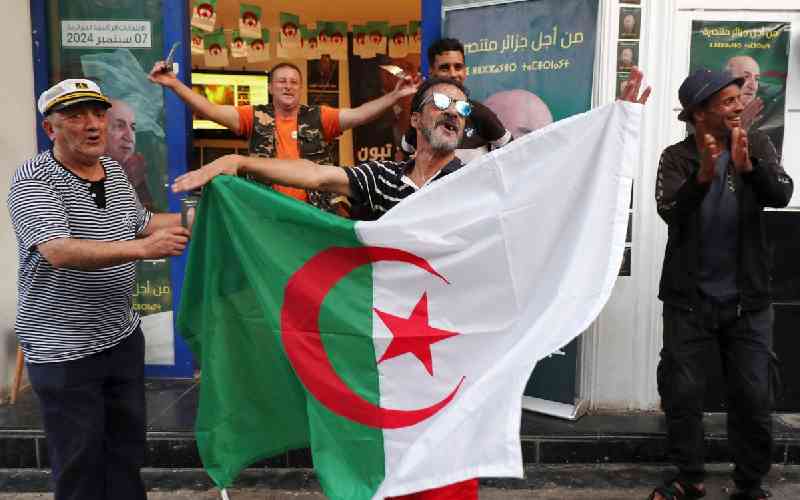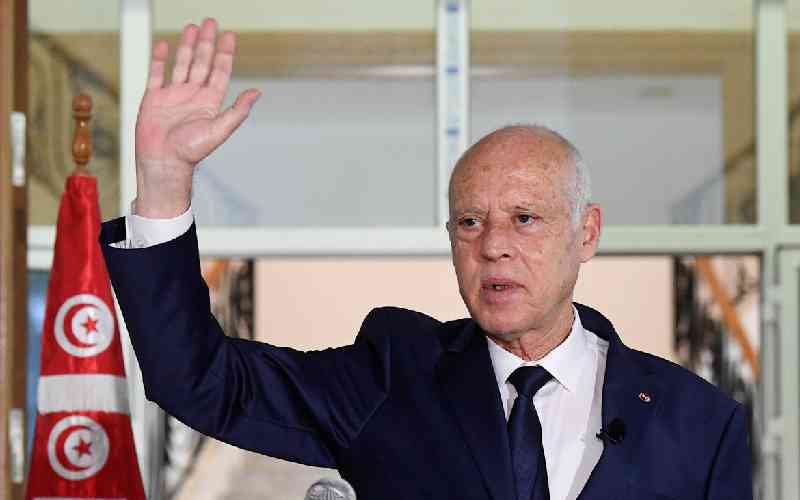
Harambee House Annex in Nairobi symbolizes the dilemma of the office of Deputy President in Kenya, and its significance for the presidential poll on August 9.
In its heyday, Nairobi’s Shell House was a beehive of commercial activities. Standing across the road from the Office of the President in Harambee House, what is today Harambee House Annex was a prestigious business address. It had such blue chip entities as Kenya Shell and Marshalls East Africa, when Peugeot was a status symbol on Kenya’s roads.
The commercial commotion into and out of this edifice, right next to the centre of power, was, however, a matter of mounting concern. It was annexed by the State, and set up as one of the nerve centres in state operations.
It has since housed the Office of the Prime Minister in the Grand Coalition Government days of President Mwai Kibaki and Prime Minister Raila Odinga. Today, however, the place is dead as a cold graveyard. Away from yawning sleepy administration police officers, who yank the gates open and close them behind the occasional vehicle, nothing much goes on around here.
This premises is the official Office of the Deputy President. The slow laidback lifestyle here speaks of the sorry state of affairs in the DP’s office. It is a frozen entity, an empty shell and far cry from the former Shell House; as a factor of the fallout between President Uhuru Kenyatta and his deputy William Ruto.
The office of the Deputy President has been emasculated of all semblances of authority and relevance. Except for the prestige of the establishment and a sprawling residence in the exclusive suburbia that is Nairobi’s Karen, there is really no major reason anyone wants to be Kenya’s deputy president. The emptiness is perhaps only mitigated by the fact that the DP could wake up as the President the following morning.
Long sight
Not one to be outwitted easily, a defiant DP Ruto has turned the residence to a beehive of a different sort. It is the fountainhead of his political campaign activities, as he takes a long sight into a possible future, with him at the helm of power. For his part, President Kenyatta has demonstrated that the deputy presidency can be reduced to nothing. For, the country’s constitution only recognizes the Deputy President as the Head of State’s principal assistant.
He shall undertake any such assignments as the President shall assign him or her. Their active participation in the affairs of State, away from the chairing of the Intergovernmental Budget and Economic Council (IBEC), resides absolutely in the hands of the President. The deputy presidency is, in the end, easily an empty sinecure position. It has no known mandates, except ceremonial roles on national days.
In spite of all this, the position of Deputy President occupies the Kenyan mind more than any other office, in the lead up to the August 9 General Election. It would seem to be the magic wand that should swing the presidential poll, one way or the other. Accordingly, community and individual stakes have been raised so high in the leading Azimio-One Kenya and Kenya Kwanza coalitions of Raila Odinga, and DP Ruto. Whom they eventually choose as their running mate, and potential occupant of this office with no obvious power, is going to play a major role in their fate in the post August 9 dispensation. It could make, or break their presidential dreams.
All eyes are of course on the Mt Kenya region, because of the nearly five million votes in the region. Yet other parts of the country cannot be ignored. The two leaders will ignore the rest of Kenya at their own political risk and peril. The mountain has especially remained warm and hugely receptive to the DP. It has always been known that this is where his deputy would come from. Yet, what does he do about the new Western Kenya entrants into his corner and the expectations of the communities in the region, and especially the Luhya nation?
The coming of Musalia Mudavadi of ANC and Moses Wetang’ula of Ford Kenya to Ruto’s corner at the start of the year was a huge boost to the national stature of his campaign effort. It was a badly needed image booster to a campaign crying for that national eminence. Equally significant has been the arrival of the Speaker of the National Assembly, Justin Muturi and his Senate counterpart Kenneth Lusaka.
Diminished chances
Mudavadi and Wetang’ula, however, took a huge gamble with their community, at a time when it was expected that Mudavadi would go all the way to the wire, despite diminished standalone chances of victory, as a factor of the Luhya community being scattered across political parties – with some standing with Raila, while others are variously with President Kenyatta’s Jubilee Party, some with Ruto’s united Democratic Alliance (UDA) and yet others behind Mudavadi and Wetang’ula.
Stay informed. Subscribe to our newsletter
It has seemed sensible that Ruto should consider one of them – and especially Mudavadi – as his running mate. Kakamega Senator, Cleophas Malala, leads the clarion call for a Mudavadi running mate role. Mudavadi previously served for a short term as President Daniel Arap Moi’s last vice president. He is as seasoned as an ace politician and statesman could be.
His urbane and stately stature makes him astute for the office of DP, or even that of president. Political logic and the game of numbers, however, make Mudavadi a risky choice for Ruto. To settle for him is to put at risk the massive Mt Kenya vote that has been canvassed for several years now. Mudavadi and the Luhya people may win the running mate battle, but Ruto and the entire Kenya Kwanza team risk losing the war.
Realpolitik dictates that Ruto should remain with the mountain. Both himself and the two Luhya kingpins must meanwhile find other ways and means of assuring the Luhya people that they will not be minions in a Ruto government, should he succeed in becoming Kenya’s fifth president. A 30 per cent share in all government positions has been floated. We will have to wait and see the details of the Kenya Kwanza coalition agreement to fully appreciate what this means. It must come with clout and a significant role in government for Mudavadi, even if is not as the deputy president.
Meanwhile, Raila faces the same dilemma. He has invested much time and other resources in wooing Mt Kenya, a region that has traditionally been averse to him, in the post “Kibaki Tosha” dispensation. One of the expectations, just like in Ruto’s case, is that his running mate will be from the mountain, if the region is to be kind to him. Raila has a rich seven-person slate of potential running mates, three of them from the region.
The names have been submitted to an advisory committee that was recently set up to guide him on whom to run with.
They include Narc Kenya’s Martha Karua, Murang’a County Woman MP, Sabina Chege, and former presidential candidate and Gatanga MP Peter Kenneth. Those from outside the mountain are Senator Gideon Moi of Baringo, former vice president Kalonzo Musyoka, Mombasa Governor Hassan Joho and Stephen Tarus of National Liberal Party.
While this rich slate should be a blessing it, in fact, presents an arduous assignment. Kalonzo is adamant that he should be the one, and even trashes the advisory process that Raila and President Kenyatta have set in motion. He states firmly that the matter should be left to Kenyatta, Raila and himself, having understudied Raila twice and having served as vice president under Kibaki.
He is Azimio’s horn of dilemma. If the coalition caves in, and accedes to his demands, the mountain is as good as lost, and with it the election. If they don’t give him, a massive chunk of the 2.2 million Akamba vote stands to be lost, even if Kalonzo stays on, and campaigns for Raila. This is hugely a factor of the levels of expectations that Kalonzo has, himself, raised among his supporters. To back down now will leave them both despondent and apathetic.
Karua is a late entrant on to the Raila/Uhuru bandwagon. Indeed, she has been opposed to their politics for much of the Handshake tenure, when most of their energy was on the Building Bridges Initiative (BBI). Karua was part of the court efforts that floored the BBI agenda. Regardless, she eventually elected to settle with Raila/Uhuru, for the August 9 election.
Rowdy crowds
She has traversed rocky terrain in the Mt Kenya region in an unremitting effort to popularise Raila. She has seen how difficult it can be, sometimes pleading helplessly with rowdy crowds not to disrupt their meetings. One of the expected dividends is certainly that she will be on the Raila ticket. If she is not, and neither Kenneth nor Chege makes it to that ticket, Raila will kiss the mountain goodbye, regardless of how hard anybody may campaign for him on an already difficult terrain.
Chege is a rather surprising entrant, submitted by Jubilee Party alongside Kenneth. While she has been faithfully by Raila’s side, it has not appeared that she was being considered for the deputy president’s role. Just how much support she could marshal for the ticket remains to be seen. Equally difficult to tell at this point is how much influence Kenneth has in the region.
Without a doubt, all the three mountaineers – Kenneth, Karua and Chege – have little push in Mt Kenya East, among the Embu, Mbeere, Meru and Tharaka.
Their best hope remains in the West, among the Kikuyu. Even here, however, a tide of rebellion against Uhuru and the Raila assignment, is in the works. Not even denial will take it away. In the circumstances, does Raila take a gamble with the Akamba 2.2 million votes and forget about the mountain, or does he keep trying his luck with the five million-plus mountain vote? It is a difficult place to be in.
Meanwhile, while his traditional Nyanza and Nairobi support bases remain reasonably constant, his hold on Western is shaky, after the flight of Mudavadi and Wetang’ula.
His new brigade in the region, fronted by Defence Cabinet Secretary Eugene Wamalwa is putting on a brave face. Deep down, however, they ought to know that the task ahead is Herculean.
Wamalwa has yet to establish himself firmly as one of the kingpins in the region. His understudies of Kanduyi MP Wafula Wamunyinyi and his Tongareni counterpart Eseli Simiyu, are not being felt in Western. Their Democratic Alliance Party of Kenya (DAP-K), is fielding underling candidates in much of the region, for the original enthusiasm about the new outfit has not morphed into the euphoria that was expected. With political ecstasy missing from the DAP-K equation, it will be interesting to see how much support Wamunyinyi and Simiyu can bring Raila, in a context where his running mate comes from elsewhere, and no clear benefit for the region in a Raila led government.
That Governor Wycliffe Oparanya of Kakamega is not politically active on the scene makes the task in Western doubly difficult for Raila, especially with Ruto making repeated forays here. A cold war between Oparanya and Wamalwa is to blame. With ODM, where Oparanya also belongs, the Joho plank is expected to keep the coast roped in, especially now that Kilifi’s Governor Amason Kingi and his PAA party are not happy with the internal dynamics in Azimio and could mobilise voters against the alliance that seems to have taken parties other than ODM and Jubilee hostage, against their better knowledge and will.
Azimio is alleged to have been scanty on disclosures to some of the partners, and has now locked them in, almost like inmates who cannot be released from captivity until after April next year. Kingi and others, like Governor Alfred Mutua of Machakos, claim that there have been underhand activities regarding the Azimio coalition agreement. They would, accordingly want to opt out.
They have learned to their dismay, however, that they are locked in, until well after the elections. While the constitutionality of such an agreement can be challenged in court, they remain locked in. As disgruntled captives, however, they are likely to be hostile members of Azimio.
It behooves Joho and other like-minded leaders, like Ngilu, to hold the Coast and Lower Eastern together for Raila. To boost their effort, they would each expect the DP’s perch. Yet their victory here would be pyrrhic, for it could only spell loss of the rest of the rich vote areas.
Big tribes
Both Raila and Ruto have to discover other incentives to float to both populous vote areas and the rest of the country. They must reckon with the reality that the country is bigger than the big tribes. But even within the big tribes, they must play their cards to the satisfaction of the communities.
The notion of a chief cabinet secretary, or prime cabinet secretary, with an assistant, or two, could help to diminish the challenge. They would, however, still have to unbundle the meaning of these positions, to show that they come with some clout and benefits to the country and regions.
Empty shell positions, such as the DP has been, may be frowned upon. The fallout between Uhuru and Ruto is rudely waking up the country to the reality that Uhuru may never have intended that the deputy presidency should have any clout, for example. While previous presidents gave a ministry to the vice president, Uhuru left his deputy without any.
To crown it all, he appointed someone else the coordinator of ministry affairs. Ruto and Raila need to rise above this and demonstrate to Kenyans – in practical lineups that they may need to release this early – that they intend to share power and government with those who are supporting them. This might diminish their running mate headache somewhat.
The writer a strategic communications adviser
 The Standard Group Plc is a
multi-media organization with investments in media platforms spanning newspaper
print operations, television, radio broadcasting, digital and online services. The
Standard Group is recognized as a leading multi-media house in Kenya with a key
influence in matters of national and international interest.
The Standard Group Plc is a
multi-media organization with investments in media platforms spanning newspaper
print operations, television, radio broadcasting, digital and online services. The
Standard Group is recognized as a leading multi-media house in Kenya with a key
influence in matters of national and international interest.
 The Standard Group Plc is a
multi-media organization with investments in media platforms spanning newspaper
print operations, television, radio broadcasting, digital and online services. The
Standard Group is recognized as a leading multi-media house in Kenya with a key
influence in matters of national and international interest.
The Standard Group Plc is a
multi-media organization with investments in media platforms spanning newspaper
print operations, television, radio broadcasting, digital and online services. The
Standard Group is recognized as a leading multi-media house in Kenya with a key
influence in matters of national and international interest.








